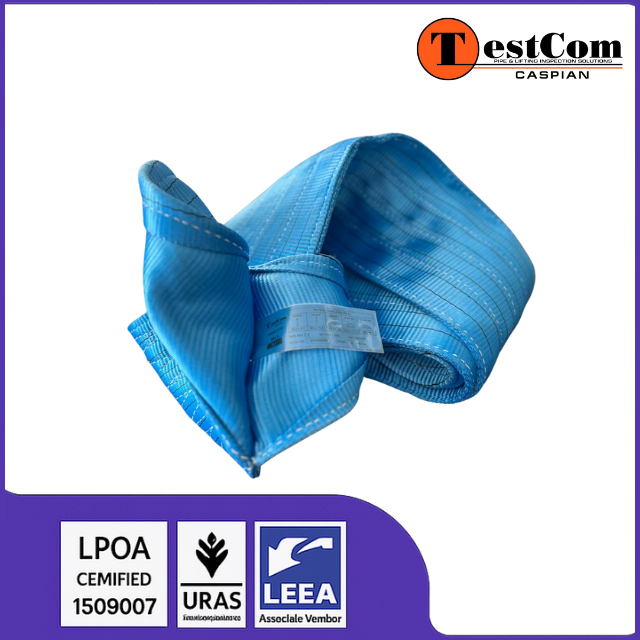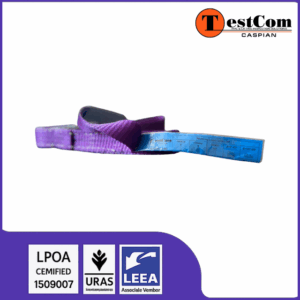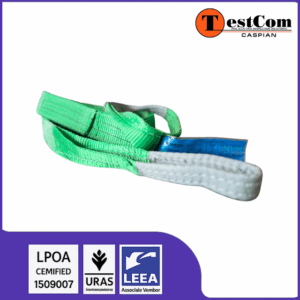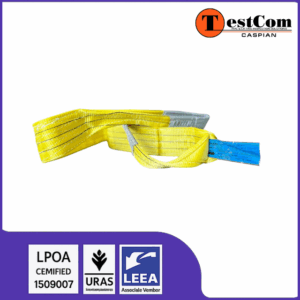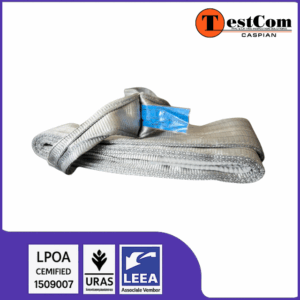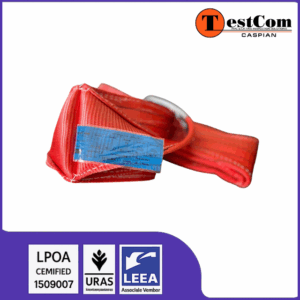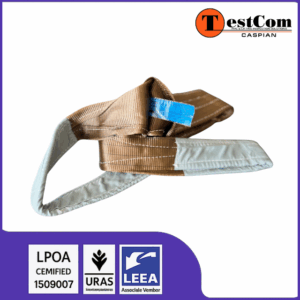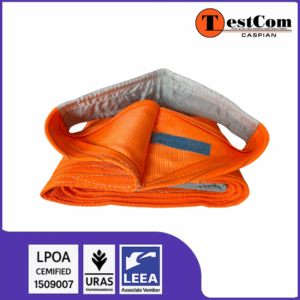8t Flat Webbing Sling EN 1492-1
240mm 8t duplex flat webbing sling blue colour to EN 1492-1 Webbing slings are usually made from polyester, and are designed to lift heavy loads, which are flexible, lightweight and have a wide bearing surface.
TestCom Flat Woven Webbing Sling to EN 1492-1
- Flat woven webbing slings, also commonly known as belt slings, are used for a variety of lifting purposes.
- Made from high-tenacity polyester yarn (PES), resistant to most acids but not to strong alkalis.
- Duplex construction, PU-impregnated, thermally fixed.
- With reinforced soft eyes.
- Colour coded for easy capacity recognition.
- Capacity stripes: each stripe is equal to 1 tonne capacity.
- Low elongation, lightweight and flexible.
- It is less damaging on contacting load surfaces than metal slings.
- Each sling is marked with a unique serial number for safe sling registration.
- Year/Month calendar printed on the label where next inspection date can be marked or punched.
- Standard: EN 1492-1
- Safety Factor: 7:1
| Item No. | Colour coded according to EN 1492-1 |
Width (mm) | Working Load Limits in Tonnes | Product Code | ||||
|---|---|---|---|---|---|---|---|---|
| Straight Lift (M = 1) |
Choked Lift (M = 0.8) |
Basket Hitch β 0°–45° (M = 2) |
Basket Hitch β 45°–60° (M = 1.4) |
Basket Hitch β 60°–90° (M = 1) |
||||
| WS01-03001 | WLL 1T | 30 / 50 | 1.0 | 0.8 | 2.0 | 1.4 | 1.0 | 301003001 |
| WS01-06002 | WLL 2T | 60 | 2.0 | 1.6 | 4.0 | 2.8 | 2.0 | 301006002 |
| WS01-09003 | WLL 3T | 90 | 3.0 | 2.4 | 6.0 | 4.2 | 3.0 | 301009003 |
| WS01-12004 | WLL 4T | 120 | 4.0 | 3.2 | 8.0 | 5.6 | 4.0 | 301012004 |
| WS01-15005 | WLL 5T | 150 | 5.0 | 4.0 | 10.0 | 7.0 | 5.0 | 301015005 |
| WS01-18006 | WLL 6T | 180 | 6.0 | 4.8 | 12.0 | 8.4 | 6.0 | 301018006 |
| WS01-24008 | WLL 8T | 240 | 8.0 | 6.4 | 16.0 | 11.2 | 8.0 | 301024008 |
| WS01-30010 | WLL 10T | 300 | 10.0 | 8.0 | 20.0 | 14.0 | 10.0 | 301030010 |
| WS01-30012 | WLL 12T | 300 | 12.0 | 9.6 | 24.0 | 16.8 | 12.0 | 301030012 |
ALWAYS:
Webbing slings are available in a range of materials and sizes in single-leg and endless forms. Select slings and plan the lift taking into account:
• Material — polyester (blue label) resists moderate acids; polyamide / nylon (green) resists alkalis; polypropylene (brown) resists most acids / alkalis but is attacked by some solvents.
• Capacity — sling must be long & strong enough for the load and slinging method (apply correct mode factor).
• Temperature limits: Polyester & Polyamide – 40 °C … +100 °C; Polypropylene – 40 °C … +80 °C.
• For multi-leg slings the angle between legs 30°–90°.
• Use protective sleeves/packing on sharp edges.
• Grade 8 fittings must not be used in acidic conditions. Storing and Handling Webbing Slings
Never return wet, damaged or contaminated slings to storage. Clean with clear water and dry naturally. Store hung on non-rusting pegs in a dry, clean, shaded area. Do not alter or repair slings yourself. Using Webbing Slings Safely
Do not attempt lifts unless you understand the procedures and mode factors. Check correct engagement with fittings, avoid twists, spread load uniformly, keep stitching away from hooks, take loads steadily, avoid shock loads, never leave suspended loads unattended. In-service Inspection and Maintenance
Before each use inspect slings. Remove from service and refer to a Competent Person if you find: illegible markings; cuts; damaged stitching; heat or chemical damage; burns; solar degradation; deformed fittings.
- Store and handle webbing slings correctly.
- Inspect webbing slings and accessories before use and before placing into storage.
- Follow safe slinging practices, as given overleaf.
- Position the bight for choke lift at 120° (natural angle).
- Position the sling so that the load is uniformly spread over its width and protect the sling from sharp edges.
- Apply the correct mode factor for the slinging arrangement.
- Attempt to shorten, knot or tie webbing slings.
- Expose webbing slings to direct heat or flames.
- Use webbing slings at temperatures above 80 °C or below 0 °C without consulting the supplier.
- Expose webbing slings to chemicals without consulting the supplier.
- Shock load webbing slings.
- Use webbing slings which are cut or which have loose or damaged stitching.
- Use a sling with a missing/damaged label or illegible markings.
Webbing slings are available in a range of materials and sizes in single-leg and endless forms. Select slings and plan the lift taking into account:
• Material — polyester (blue label) resists moderate acids; polyamide / nylon (green) resists alkalis; polypropylene (brown) resists most acids / alkalis but is attacked by some solvents.
• Capacity — sling must be long & strong enough for the load and slinging method (apply correct mode factor).
• Temperature limits: Polyester & Polyamide – 40 °C … +100 °C; Polypropylene – 40 °C … +80 °C.
• For multi-leg slings the angle between legs 30°–90°.
• Use protective sleeves/packing on sharp edges.
• Grade 8 fittings must not be used in acidic conditions. Storing and Handling Webbing Slings
Never return wet, damaged or contaminated slings to storage. Clean with clear water and dry naturally. Store hung on non-rusting pegs in a dry, clean, shaded area. Do not alter or repair slings yourself. Using Webbing Slings Safely
Do not attempt lifts unless you understand the procedures and mode factors. Check correct engagement with fittings, avoid twists, spread load uniformly, keep stitching away from hooks, take loads steadily, avoid shock loads, never leave suspended loads unattended. In-service Inspection and Maintenance
Before each use inspect slings. Remove from service and refer to a Competent Person if you find: illegible markings; cuts; damaged stitching; heat or chemical damage; burns; solar degradation; deformed fittings.
